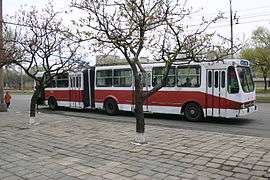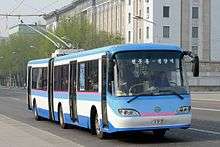Trolleybuses in Pyongyang
The Pyongyang trolleybus system forms part of the public transport network of Pyongyang, the capital city of North Korea, and extends to some of its suburbs.
| Pyongyang trolleybus system | |
|---|---|
 PTWC trolleybus. | |
| Operation | |
| Locale | Pyongyang, North Korea |
| Open | 1962 |
| Status | Active |
| Routes | 10 |
| Infrastructure | |
| Depot(s) | 3 |
| Stock | More than 300 trolleybuses. |
In operation since 30 April 1962, the system was about 57 km (35 mi) long in 2009 and comprised 10 routes.[1]
Fleet
Most of the vehicles used on the system are North Korean made; some of them based on the Czech Karosa buses. The fleet also includes Hungarian Ikarus trolleybuses, imported as diesel buses and later reconstructed into trolleybuses.
 A trolleybus outside the Pyongyang Station.
A trolleybus outside the Pyongyang Station. Pyongyang trolleybus, 2008.
Pyongyang trolleybus, 2008. PTWC trolleybuses.
PTWC trolleybuses. A domestically produced Chollima-091, 2014.
A domestically produced Chollima-091, 2014.
New Rolling Stock
North Korea is manufacturing new trolleybuses domestically, according to footage from the state run Korean Central Television (KCTV).
New model buses appear to be slowly working their way into circulation, with North Korean media reporting on the development of other buses types in Chonjin as part of the recently concluded 70 day labor campaign.[2][3]
But while the trolleybuses are replacing their older counterparts, it’s unclear if they are as state of the art as the KCTV footage claims.
“I mean for example the tailgate lights they aren’t electronic, they are just reflectors, like the sort of reflectors they have on bicycle wheels, so that’s on the back on the bus. Very simple lighting. They are not air-conditioned, you always see them driving around with the windows open,” Rowan Beard from Young Pioneer Tours told NK News.
The lower tech trolley buses contrast with Pyongyang’s newly implemented subway trains which come with LCD monitors and bright lighting.[4]
Flickr user Moravious first snapped one of the newer model trolleybuses back in 2010, calling the vehicle a “prototype.” The pictured bus looks similar to the newer ones currently around Pyongyang, but has a blank license plate.
The lack of fanfare around the trams and trolley buses contrasts with the coverage the recently added subway cars received. North Korean leader Kim Jong Un personally tested the modernized subway trains, and they were even the focus of subway stamps and propaganda posters.[5]
The emphasis on domestic production is currently an increasing trend in North Korea media, which has recently highlighted locally made North Korean computers, solar panels, ships and more general sectors like metallurgy.
See also
- List of trolleybus systems
- Pyongyang Metro
- Pyongyang tram system
- Trams and trolleybuses in North Korea
- Transportation in North Korea
References
- "Trolleybus city: Pyongyang". 3 March 2009. Retrieved 12 August 2011.
- https://www.nknews.org/2016/06/north-korea-manufacturing-new-trolleybuses-domestically/
- https://exploredprk.com/articles/new-model-of-trolley-buses-manufactured/
- https://www.nknews.org/2016/06/north-korea-manufacturing-new-trolleybuses-domestically/
- http://www.nkleadershipwatch.org/2015/11/19/kim-jong-un-rides-the-py-subway/
External links
![]()
- "Trolleybus city: Pyongyang". Trolleymotion.